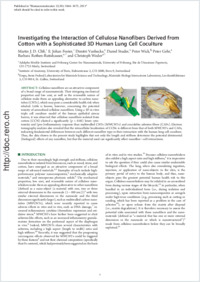Investigating the interaction of cellulose nanofibers derived from cotton with a sophisticated 3D human lung cell coculture
- Clift, Martin J. D. Adolphe Merkle Institute and Fribourg Center for Nanomaterials, University of Fribourg, Switzerland
- Foster, E. Johan Adolphe Merkle Institute and Fribourg Center for Nanomaterials, University of Fribourg, Switzerland
- Vanhecke, Dimitri Institute of Anatomy, University of Bern, Switzerland
- Studer, Daniel Institute of Anatomy, University of Bern, Switzerland
- Wick, Peter Empa, Swiss Federal Laboratories for Materials Science and Technology, Materials-Biology Interactions Laboratory, St. Gallen, Switzerland
- Gehr, Peter Institute of Anatomy, University of Bern, Switzerland
- Rothen-Rutishauser, Barbara Adolphe Merkle Institute and Fribourg Center for Nanomaterials, University of Fribourg, Switzerland
- Weder, Christoph Adolphe Merkle Institute and Fribourg Center for Nanomaterials, University of Fribourg, Switzerland
-
16.08.2011
Published in:
- Biomacromolecules. - 2011, vol. 12, no. 10, p. 3666–3673
English
Cellulose nanofibers are an attractive component of a broad range of nanomaterials. Their intriguing mechanical properties and low cost, as well as the renewable nature of cellulose make them an appealing alternative to carbon nanotubes (CNTs), which may pose a considerable health risk when inhaled. Little is known, however, concerning the potential toxicity of aerosolized cellulose nanofibers. Using a 3D in vitro triple cell coculture model of the human epithelial airway barrier, it was observed that cellulose nanofibers isolated from cotton (CCN) elicited a significantly (p < 0.05) lower cytotoxicity and (pro-)inflammatory response than multiwalled CNTs (MWCNTs) and crocidolite asbestos fibers (CAFs). Electron tomography analysis also revealed that the intracellular localization of CCNs is different from that of both MWCNTs and CAFs, indicating fundamental differences between each different nanofibre type in their interaction with the human lung cell coculture. Thus, the data shown in the present study highlights that not only the length and stiffness determine the potential detrimental (biological) effects of any nanofiber, but that the material used can significantly affect nanofiber–cell interactions.
- Faculty
- Faculté des sciences et de médecine
- Department
- AMI - Chimie des polymères et matériaux
- Language
-
- English
- Classification
- Physics
- License
- License undefined
- Identifiers
-
- RERO DOC 27400
- DOI 10.1021/bm200865j
- Persistent URL
- https://folia.unifr.ch/unifr/documents/302056
Statistics
Document views: 130
File downloads:
- wed_iic.pdf: 311
